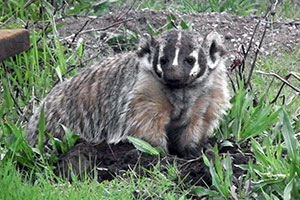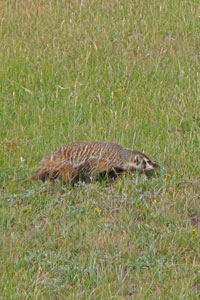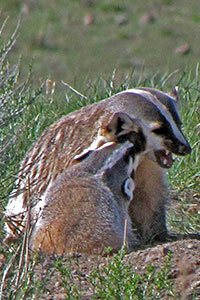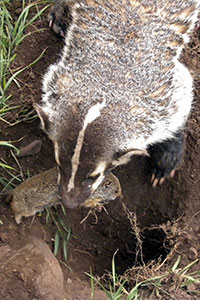
Yellowstone Badger: A Citizen Naturalist Project
Become involved
We would love to have your help, whether it be reports and photographs of badgers or your comments on existing photos! To get started, follow these simple steps:
Creating a username and password allows you to upload reports and photographs, as well as make comments on existing reports and photographs uploaded by other users.
Log in (or create an account from the upper right corner) and click one of the "Upload Report" links under the "My Info" tab on the toolbar. We will accept any photos in JPG format, however, those most useful from a scientific perspective will be those in focus and fairly zoomed-in and cropped tightly. (Please be reminded that the legal distance for viewing/photographing badgers in Yellowstone is 25 yds!) We anticipate receiving all kinds of photographs, but examples of those that are particularly useful are in Figures 1-4.
Once you have added and uploaded all your photographs (if any), click on "Done uploading—Enter data". The data entry form (Figure 5) will pop up allowing you to enter accompanying data.
The "Date," "Time," and "Location" are extremely important, and may be the only things that you are able to fill out. The location can be a description as basic as "Lamar Valley" or "Hayden Valley," but the more detailed locations such as "Lamar Valley, south of the Buffalo Ranch" or "Three miles south of Canyon Village" will be most helpful in allowing us to cross-check and identify individual IDs. To enter the estimated latitude and longitude of where the badger was seen, click on the green globe icon and drag the marker to the appropriate location on the map.
Tell us how many animals you observed. Please enter a short description that includes body size and color of each animal unless a photograph shows colors well. Describe the behavior of the badger(s). The more detail the better. In the notes section, please enter any other information that might help understand and analyze your sighting.
Finally, select whether you would like the photo to be publicly available (if not, we use it strictly for research purposes) and whether you would mind if we used your photograph for educational purposes (public lectures, informational handouts, or scientific presentations/papers). Press "Save report information."
If you have multiple images taken at the same location, you will have the option to automatically copy the data onto the next report's data form. You can then quickly edit the ID or notes section without having to re-enter the same location or pack data.
It may take us a few days to cross-check and validate your report before it is publicly displayed (if you selected this option).
Once you have a user ID, you will be able to comment on existing reports. This comment period will eventually close after a period of time has elapsed.
 Figure 1. This is an example of a good picture of a badger digging at the porch of the Lamar Buffalo ranch. It shows good identification characteristics.Photo by Jim Halfpenny
Figure 1. This is an example of a good picture of a badger digging at the porch of the Lamar Buffalo ranch. It shows good identification characteristics.Photo by Jim Halfpenny Figure 2. A distant photo of a badger proving its identification and offering some hints as to fur pattern and coloration. Photo by Jim Halfpenny
Figure 2. A distant photo of a badger proving its identification and offering some hints as to fur pattern and coloration. Photo by Jim Halfpenny Figure 3. A photo of a mother and her kit which allows verification of two age classes and color patterns. Photo by Jim Halfpenny
Figure 3. A photo of a mother and her kit which allows verification of two age classes and color patterns. Photo by Jim Halfpenny Figure 4. This photo shows behavior of a badger, in this cases active predation under the porch of the Buffalo Ranch in Lamar Valley. Photo by Leo Leckie
Figure 4. This photo shows behavior of a badger, in this cases active predation under the porch of the Buffalo Ranch in Lamar Valley. Photo by Leo Leckie